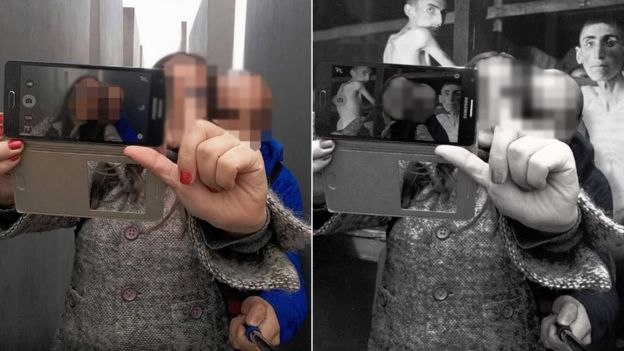The power of words and images has been central to society and the news in recent years, as fake news rises and ethical debates gained importance. Social media platforms changed the game, and as our Insta society keeps growing, so do ethical issues around how people should behave in public.
Two years ago, a discussion around commemoration was raised when Berlin-based Israeli artist, Shahak Shapira, released his Yolocaust photo series.
The artist believed that people’s behaviour at the Memorial was disrespectful, and decided to highlight this by superimposing people’s photographs at the Holocaust Memorial in Berlin onto actual Holocaust images.
How should we behave in memorial spaces? An etiquette and ethical question
After Shapira’s work went viral, different perspectives on his work and commemoration emerged. Lizzie Post, of the Emily Post Institute —an etiquette institute— argued that some spaces should be off-limits for selfies, because it could be disrespectful. However, she makes the distinction between “duck-face selfies” —as an example of disrespectful behaviour— and selfies that simply say ‘I was here’.
There are two main schools of thought about why people take selfies in commemorative spaces: self-centredness and self-documentation.
Susan Sontag, in her seminal work On Photography, described how images are changing the relationship between us and the world. She writes that: “Photographs… help people to take possession of space in which they are insecure. To photograph is to appropriate the thing photographed. It means putting oneself into a certain relation to the world that feels like knowledge — and, therefore, like power.” She saw the act of taking a photograph or selfie as a coping mechanism for dealing with the complexity of the space and their feeling towards it: in moments when we are confronted with overwhelm or confusion, we seek to lighten that burden with a photograph. In doing so, we make it all about ourselves. This interpretation, however, is that it assumes that people only have one motivation, one that is self-centred.
Lilit Marcus adds to this theory by arguing that the Holocaust Memorial has become yet another “must-see” tourist trap, akin to the Mona Lisa or the Leaning Tower of Pisa, that has lost its meaning only to become an attraction that people want to tick off their bucket list.

The self-documentation theory was raised by Caitlin Dewey of the Washington Post, who argued that selfies at commemorative sites do not always have a self-centred motivation. She wrote: “While self-portraits are understood by many to be little more than a flagrant show of narcissism or a plea for attention, they may mean something different to the taker. It’s less a matter of self-glorification than self-documentation — ‘I was here.’ ‘This happened.’” This was the former vice-president of the Czech Senate, Zdenek Skromach’s reasoning. A photograph of himself at a Czech concentration camp caused outrage, but he justified it as: “I did not take a selfie, I took pictures to document the event, as I usually do.”
The latest theory to have emerged is that of self-transformation, fronted by Irit Dekel, who argues that when people engage with memorials, they go through a moral transformation, especially through the revelation of feelings such as sadness. Dekel uses the work of anthropologist Jackie Feldman to suggest that if they are seen as having failed to transform (celebrate or commemorate) properly, then they have failed to act appropriately. This failure is discussed in ethical terms. This is why many people have condemned those selfies.
From figurative to abstract, has architecture influenced the way we act in sacred spaces?
Could an explanation –yet not a justification– for people taking selfies at memorials link back to the shift in memorial art, from figurative to abstract and minimalistic –and thus more Instagrammable?
This is what Russell Rodrigo, a senior lecturer and researcher in architecture at UNSW Sydney, argues. He told us: “Where figurative representation is limited by singular meaning, there is more potential for multiple interpretations with abstract representation.” Thus, having a more abstract memorial has various advantages, namely that everyone can identify with it however they wish and that it allows for personal interpretation and experiences at the same time as a communal experience. “This has changed the memorial’s relationship with the viewer, leaving them unaware of the significance of the memorial,” linking back to Lilit Marcus’s theory of a bucket list, “been there, done that”.

The architect behind the Holocaust Memorial, Peter Eisenman, said himself that the Holocaust Memorial “is not a sacred place,” and leaves the rules of engagement open for debate. But by leaving the rules open, memorials do not guide people and give clues as to how to behave, unlike in private spaces where the rules are more clearly defined.
Ground Zero attempted to control people’s behaviour with signs saying “Please be reminded that the 9/11 memorial is a place of remembrance and quiet reflection … Visitors should exercise proper conduct at all times.” Yet, a quick Google or Instagram search comes up with many images of people taking selfies at the memorial site.
Should artists do more to encourage more respectful behaviours? The debate was raised during the competition for London’s new Holocaust Memorial. The brief called for “an outstanding, ambitious, sensitive design that creates an emotionally powerful place for reflection and learning”, something “sombre but not shocking” to “convey the magnitude of what happened in a meaningful and comprehensible way” and “give visitors a deeper understanding of the Holocaust and its victims”.
Two years on, the winning project is still not under construction, with recent opposition from Royal Parks with regards to its location.




